Is Your System Well Grounded? Consider These Points in Effective Grounding
Grounding is the most fundamental property of all types of electrical equipment. There are plenty of quality articles on specific subjects in In Compliance Magazine and in other publications, largely on grounding on a printed circuit board (PCB) level. This article focuses on a path less traveled, grounding on a system level, that is grounding of the equipment in actual use at the factories.
There are several key aspects of grounding, including safety, electrostatic discharge (ESD), electromagnetic interference (EMI), and signal integrity. While this and other magazines have published detailed articles on one or more of these subjects, this article combines them all to assist equipment users and tool makers in understanding what is important and how to achieve optimal ground performance. This article does not cover PCB grounding (there are plenty of excellent articles on this subject) and portable tools with double insulation that do not have grounding.
Safety
Safety is always first. Too many specialists in ESD and EMI are not professionally trained in electrical safety. This article is far from a comprehensive safety guide, and it doesn’t cover every important safety point. The whole purpose of this section is to bring electrical safety to the attention of ESD and EMI specialists at factories and tool designers who otherwise may not be aware that grounding is a safety item. I strongly recommend that those who deal with such subjects take an electrical safety course, make friends with factory’s licensed electricians, or join a factory safety committee. In this article, we will just scratch the surface and touch on the basics.
So why is grounding a safety element? As an example, let us consider a typical piece of industrial equipment, such as an integrated circuit (IC) handler, or surface mounted technology (SMT) pick-and-place machine (or any other tool that you are familiar with). Each of these tools takes its power from AC mains, meaning that typically anywhere from 100VAC to 440VAC enters the equipment. If a live wire inside such a machine or tool gets loose for whatever reason, it can touch and energize (that is, supply voltage to) a metal part to which an operator has access. Now this metal part, such as the enclosure, is under high voltage. The operator can easily be electrocuted simply by touching such a part.
Here is where grounding comes to the rescue. If all operator-accessible metal parts are properly grounded, an energized loose wire that touches such a part effectively short-circuits any live voltages to ground, and the resulting excessive current triggers the circuit breaker to cut power to the tool. For all this to work, these conditions must be met:
All operator-accessible conductors must be grounded1; and
- The ground path must have a low enough impedance to allow a high current sufficient to trigger the circuit breaker.
How conductive should a ground path be in order to trigger the circuit breaker? There are several varying standards and guidelines on this subject, but the essential answer is that the ground path should be at least as conductive as either the live or neutral paths. If your power cable utilizes AWG12 (or 2mm diameter) power wires, you cannot have ground wires that are thinner than that. A ubiquitous AWG18 green wire just won’t do.
Must all grounding wires inside the tool be as thick as the power wires that enter it? Not necessarily. In places where grounding is done for purposes other than safety (for example, ESD/EMI) and where there are no voltage-carrying conductors, grounding wires can be selected based on other criteria (see further on in this article).
Ground and Neutral Reversal
More often than desired, ground and neutral wires are reversed in either facility wiring or in the internal wiring of the equipment itself. This leads to return current flowing through ground rather than through the neutral wire, resulting in a multitude of functional problems in addition to being a safety issue. A ubiquitous three-LED outlet checker cannot detect that. The easiest way to check for it is to measure AC current on the ground wire entering the equipment using a simple AC current clamp (make sure to properly identify ground wire). If the equipment ground current exceeds 0.1 A during operation, an investigation is in order. This does not account for excessive leakage current in equipment even if the wiring is correct.
ESD
After safety, the second most common use of grounding in equipment is to address ESD considerations, more specifically, to provide a discharge path to ground for conductors and static-dissipative materials. If accumulated static charges on electrically floating conductors and dissipative materials are not discharged to ground potential, they may carry unwanted voltage and cause problems for ESD-sensitive devices.
How do we effectively ground such objects? Standards such as ANSI/ESD S6.1[1] and an omnibus standard ANSI/ESD S20.20 [2] provide good recommendations. Here we will add some helpful narrative.
It is curious to me that engineers and technicians dealing with grounding issues don’t ask the most important and logical question about ground, that is, what is the voltage on ground? Not the resistance since resistance is just the means of reducing the voltage on grounded parts. The whole purpose of grounding for ESD purposes is to create an equipotential environment.
There are currently no coherent standards, standard practices, or technical reports issued by either the ESD Association or the IEC that touch this subject with any specifics on validation. Yet, this is the most important question for the safety of the devices in the process. The only document addressing it is SEMI Standard SEMI E.176 [3] which I’ll cover later in this article.
How do we assure that what needs to be grounded actually is? There are implicit and explicit ways of providing grounding connections. Implicit ways include mechanical fastening of conductive parts of the tool to the grounded frame so that there are no obvious grounding wires, but the electrical connection via mechanical fastening is still present and is adequate. The problem with such implicit connections is that they are uncontrolled. Depending on the construction of the tool, any component in the electrical connection chain can be altered in the next revision of the tool or during repair or service and modified to the degree where the electrical connection is no longer assured. During any revision, maintenance, or repair, a metal washer can be replaced by a nylon one, or an originally bare metal part may become anodized, and so on.
There are two ways to prevent such problems. One way is to add requirements for adequate ground connection to the tool’s specification and to the maintenance procedure and verification documentation (and to meticulously follow it). Another way is to use an explicit, separate grounding method. Either of these methods is viable, and the choice is up to the user of the equipment since its manufacturer may not appreciate the importance of proper grounding for ESD.
An example of explicit grounding is shown in Figure 1. I’ll come back to this figure later in this article.
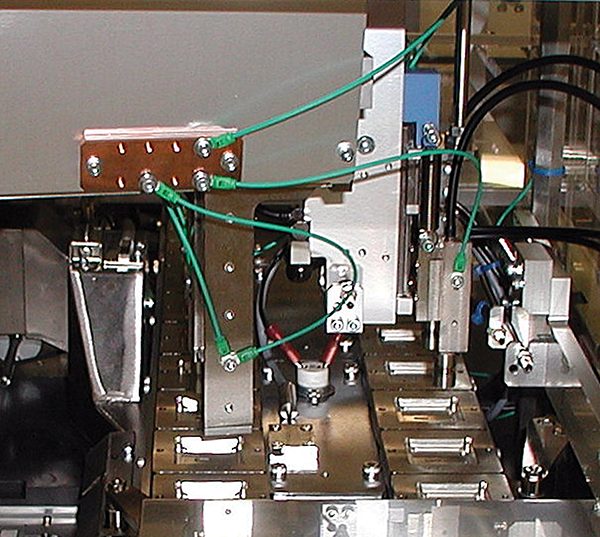
ESD Ground: How Good is Good?
Various ESD-related standards such as ANSI 6.1, ANSI/ESD S20.20, ESD S10.1 [4], IEC 61340 [5], and some other documents, plus proprietary factory-wide documents, provide guidance on grounding. This section simply attempts to provide clarification on some of the details.
Metal Ground
For explicit grounding and for the grounding of floating metal parts, these documents specify (or recommend) a resistance path to ground of less than 1 Ohm. While this goal is reasonably easy to achieve with stationary equipment, it can be quite elusive and not feasible for some of the moving parts.
If the part moves just a little (even just a few centimeters, as is common in many tools) grounding is often done using flexible steel cable (quite similar to a bicycle brake cable, see Figure 2). Careful selection of material, flex radius, and the number of bend cycles of such cables is required to avoid breakage of the cable in use. Obviously, steel is not as good a conductor as copper, but it is much more durable. And, with very short cable runs, resistivity isn’t really an issue.
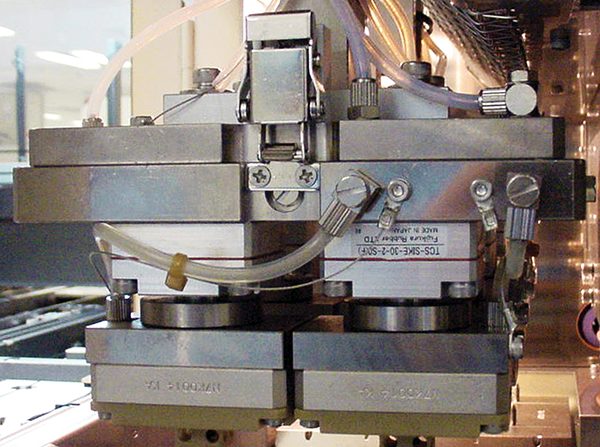
Longer movements require much longer runs of ultra-flexible cables protected by flex conduits, as shown in Figure 3. The internal construction of such flex cables does not support a sufficiently thick gauge of wire. Therefore, many ultra-flexible cables include an additional layer of Teflon or similar material around each wire that facilitates a low friction coefficient, allowing wires to slide against each other while bending.
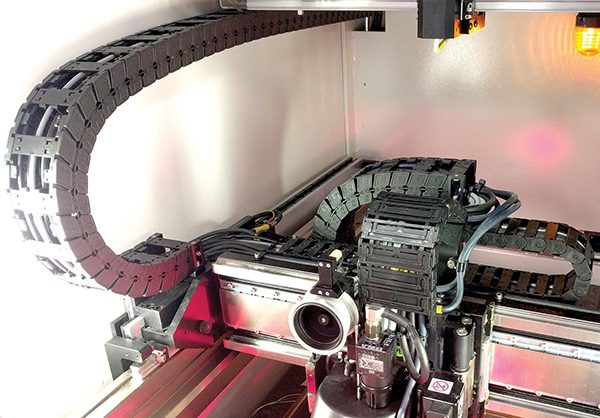
This would be the case with any ultra-flex cables, with or without an external harness, as shown in Figure 2. The result is higher resistivity of such wires, making a 1 Ohm requirement of the entire connection almost unachievable, considering all the interconnects along the chain. Requirements to the total resistance of flex ground connections typically vary between 2 and 10 Ohms, depending on the factory, although I’ve seen 20 Ohms requirements as well. Would such an increase over 1 Ohm noticeably alter the ESD environment in the process? Actually, that’s very unlikely, but what would cause the problem is a loss of ground connection.
The problem with the reliability of explicit grounding using dedicated conductors is that the failure of a ground connection may not be obvious right away. After all, such grounding or the absence of it does not alter the basic functionality of the tool and can go unnoticed for some time. I’ve witnessed an unfortunately large number of situations where explicit ground wires were disconnected for tool’s maintenance but, instead of being reconnected, the wires were either completely removed or their ends were left hanging, making the tool look a bit like a hedgehog. And these issues typically emerge when there’s a need to resolve a sudden ESD or EMI problem.
One of the solutions to a lost ground problem is ground monitoring, and there are plenty of ground monitors on the market. Such monitors independently connect to the grounded point and to the reference ground and sound an alarm whenever a ground connection fails.
The 1 MOhm Question
Wriststraps and/or wriststrap cords contain a 1 MOhm resistor in line with ground for a simple reason, that is, to prevent electrocution of personnel. Should an operator wearing a wriststrap accidentally touch a grounded conductor, the current through the operator should not exceed 0.5mA (ANSI/ESD S1.1 ANNEX B [7]), a limit that is consistent with several broader safety standards. At 250V RMS, which is the highest RMS AC voltage among common electrical outlets, the minimum resistance should be no less than 500 kOhms (not accounting for the electrical resistance of the operator’s body). A 1M resistor would satisfy this requirement, including dual wriststraps that would have two resistors, electrically parallel to each other, between the operator’s body and ground. Try to avoid low-cost wrist straps and cords unless their resistance is verified.
Should the same 1 MOhm resistor be used to ground other items, such as metal objects or dissipative materials? The often-stated reason for use of a 1 MOhm resistor in such applications is to slow down the discharge. Would it truly slow down the discharge?
Let us consider an electrically floating metal object that needs to be grounded. This object would have an electrical capacitance dependent on its size (among other things). Assuming that this object is at ground potential, would it make a big difference in discharge properties whether the object is grounded via sub‑Ohm resistance, via 1 M resistance, or left electrically floating?
Figure 4 shows a highly simplified equivalent electrical schematic of such a connection (parasitic inductances and capacitances have been omitted for clarity). A device (IC) has a certain capacitance, C1, and is charged, to voltage V1, likely as a result of being lifted from the tray. An IC handler’s arm is about to place this device onto a shuttle (a metal tray for moving ICs in the handler). When the IC comes in contact with the shuttle, the voltage is almost instantly equalized.
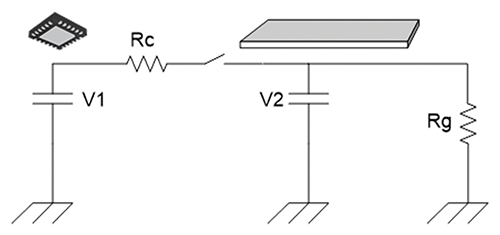
For exercise purposes, we will assume that the shuttle is implicitly grounded via resistor Rg and not by mechanical means. In the end, whatever charges were left on the shuttle will dissipate to ground via Rg. But the issue we are trying to resolve is the role that the Rg plays in the properties of the discharge itself.
Resistance Rc of contact between the IC and the shuttle is negligible, perhaps just a few milliohms. If we set Rg to 1 MOhm, most of the action will happen between the IC and the shuttle, since Rg is too large to participate in voltage equalization during a short nanosecond-long discharge. If we bring this situation to an extreme, assuming that Rg has infinite resistance, would this slow down the discharge? Of course not, since the waveform of the discharge is defined only by the capacitances of metal parts and contact resistance Rc. ESD practitioners know well that touching a floating plate of CPM easily produces discharge, just like touching a completely insulated metal doorknob would produce the same. The only function of Rg is to eventually dissipate whatever little charge the IC shared with the shuttle to ground and to bring shuttle voltage to ground potential.
The same holds true for static-dissipative mats. Inserting a 1 MOhm resistor into the ground connection will not change the rise time or amplitude of the discharge. Instead, it will only slow down the dissipation of charge to ground which, in the case of static-dissipative materials, may leave these materials under voltage in fast-paced processes. While existing practices allow a 1 MOhm resistor to be used in a ground circuit with dissipative materials, it is counterproductive in reality.
EMI
We are finally coming to the most interesting part of grounding, that is, high-frequency voltages on ground, or EMI. The term in this context may not satisfy a purist but, since it is widely used in the industry, this is what we will be using as well.
Every electrical equipment generates some sort of parasitic, for example, unplanned or unwanted signals. Automated equipment contains plenty of sources of high-frequency voltage and current signals [8], with the strongest generated by pulse-driven motors (servo, steppers, and VFD – variable frequency drives) [9], and switched-mode power supplies, including those in LED lighting as well. These high-frequency signals leak to ground via parasitic capacitance, resulting in highly undesirable voltages between different grounded parts of equipment. This is never good news, but it’s especially bad news for sensitive devices and for testing and measurement.
Why are we focusing on high-frequency voltages and not any other voltages? Simply, conventional grounding methods deal with DC and low-frequency AC voltages reasonably well. They sink to ground any leakage AC and static DC voltages that happen to be on metal and static dissipative parts of equipment, given their low ground path resistance (see the previous discussion). That leaves only high-frequency voltage signals, due to the parasitic inductance and capacitance of conductors and the mutual influence between them. While resistance path to ground can be very low for DC and for low frequencies, this is not the case for high-frequency signals, which we’ll analyze it in detail.
A Wire is an Inductor
Simple, straight wire that would be great for ESD and safety grounding is, in fact, an inductor. Although calculating this inductance may be a bit involved, there are plenty of useful Java-based inductance calculators on the internet that are far more practical [10] than doing the calculation by hand.
As a point of reference, a 1mm diameter wire (AWG18) of 1 m length has an inductance of 1.5µH. At 1MHz this would present an impedance of 9.42 Ohms. This is for the straight wire only, and the typical service loops of ground wire only add to impedance. There are calculators for that too [11]. As an example, five turns of the same wire coiled in a 6” (15cm) diameter coil produces 6.1µH inductance with an impedance of 38 Ohms at 1MHz. The same wire would have a resistance of only 0.06 Ohms at DC.
Only Outer Layer of Wire is a Conductor at High Frequency
At high frequencies, the current is pushed out by the magnetic field resulting from the passing current, the so-called skin effect. The higher the frequency, the thinner the conductive layer. At 1 MHz, the outside conductive layer is only 66µm thick. Skin effect doesn’t add as much resistance as pure inductance (1m of AWG18 wire constitutes 0.09 Ohms vs. 0.021 Ohms Ohms if there were no skin effect), but it all adds up. Multi-stranded wires help, since the bigger the wire surface the lower the resistance. But the wires typically found in manufacturing environments have too few strands to be effective.
Capacitive Coupling
Two wires running in the same conduit influence each other via capacitive and inductive coupling. In Figure 2, there are drive signals among the wires in the flex channel to servo motors on the robotic arm, along with a wire to ground the arm itself, all of which are in immediate proximity to each other. A typical robotic arm of automated equipment has three servo motors, one for each degree of freedom. This amounts to nine wires carrying pulsed voltage with typically 200V peak voltage (not counting ringing and other artifacts). The rise and fall times of such drive pulses are under 50 nS, creating signals with the spectrum extending up to 20 MHz.
In the example of Figure 2, the length of wires in the flexible harness is 3m. The capacitance between two adjacent wires would be approximately 63pF [12] which at 20MHz constitutes 125 Ohms impedance. The rough equivalent schematic would look like the one in Figure 5a.
Due to the properties of capacitive coupling, the higher the frequency, the higher the induced voltage. Correspondingly, the sharper the edges of the pulses, the higher the induced voltage.
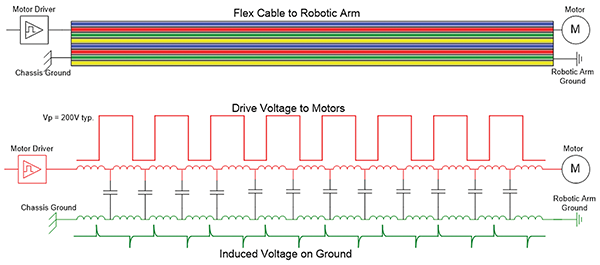

Inductive Coupling
The long wires running in parallel form a distributed transformer. Without the core and the turns of windings, it works only at higher frequencies, and this is where the problem lies. Figure 5b shows how the current in one wire imposes corresponding currents on a nearby wire. Due to the properties of this parasitic transformer, only high-frequency signals are being passed from one wire to another, creating waveforms similar to those shown in Figure 5a.
Field Data
One can get easily absorbed in simulations and calculations of induced voltages and currents. In our case, however, this is not likely to produce realistic results due to the number of variables not accounted for in the equivalent schematic, and the variability of parameters between the tools. But measurements serve a much more practical purpose. Measurement methodology and techniques are described in detail in this article [13], previously published in In Compliance.
Figure 6 shows typical voltage between the nozzle of the robotic arm in the IC handler and the chassis. The spikes correspond to the rise and fall edges of the interfering signal.
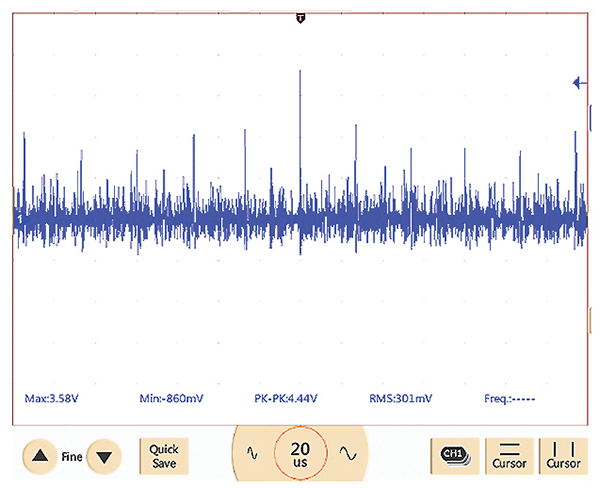
Figure 7 depicts the current between the robotic arm and the chassis in a different tool. The current was measured using Tektronix’s CT1 probe with 5mV/mA ratio, and the peak current is 76.8mA. Ringing is simply an artifact of imbalanced impedance match, and manufacturing equipment is a far cry from fully matched RF instruments.
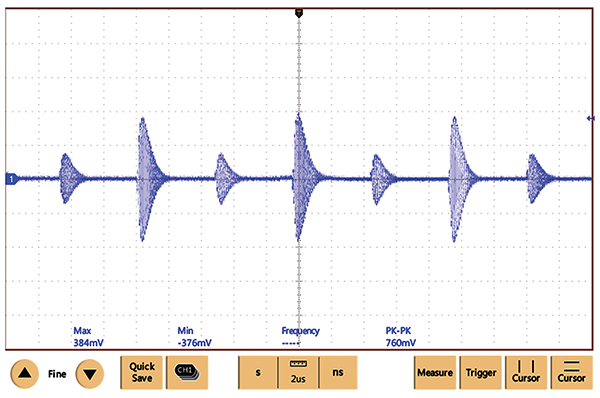
What Harm Can Little Ground Voltage Do?
What could be wrong with a little voltage between different grounded parts? In many tools and processes, it’s not a problem. If your devices are not sensitive to electrical overstress (EOS), and if you are not concerned with data integrity and measurement accuracy, there is not much to worry about. However, since you are reading this article, you must have some interest in keeping voltages and currents on ground as low as possible.
Electrical Overstress (EOS)/Electrically Induced Physical Damage (EIPD)
Grounded surfaces are supposed to provide a safe space for sensitive components without the possibility of any overvoltage exposure. But if we actually conduct measurements, the situation can be quite different and often unsafe.
Consider, for example, the common handling of ICs in an IC handler or SMT pick-and-place machine (Figure 8). An actuator/nozzle at the end of the robotic arm has plenty of high-frequency voltage vs. the chassis that we described above. A silicon die of the IC is capacitively coupled to the nozzle in its immediate proximity. At high frequencies, this capacitive coupling presents a very low impedance. When this IC is placed on either a test socket or on a shuttle (a metal holder for moving ICs in the horizontal plane), excessive current may flow through the device, weakening its structure and causing failures in the field, or even resulting in an outright failure.
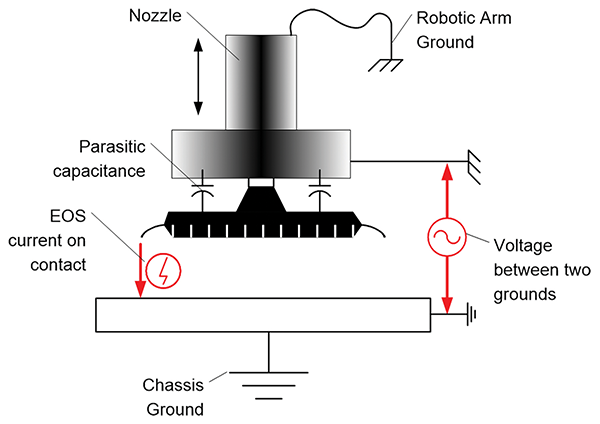
This is just one example. Any metal contact with the device, such as soldering [14], wire bonding [15], or others can expose the devices to unwanted voltages and currents.
How Much Ground Voltage and Current Are Too Much?
There are plenty of documents about controlling the resistance/impedance of ground connections. But SEMI Standard E.176 “Guide to Assess and Minimize Electromagnetic Interference (EMI) in a Semiconductor Manufacturing Environment” is the only relevant industry document that actually specifies the maximum allowed EMI voltages and currents on ground based on the properties of devices used in the process.
While written largely for semiconductor manufacturing, SEMI E.176 has a direct bearing on all applications of semiconductors, which includes most of today’s equipment. After all, the sensitivity of semiconductor devices doesn’t change once it has been shipped to a PCB assembly plant. I’ve written several articles published in previous issues of In Compliance [16] [17] that discuss SEMI E.176 in detail.
As one point of reference, today’s common IC with 10nm geometry in its unpowered state (i.e., in IC manufacturing and handling, such as PCB and product assembly) should typically not be subject to voltages higher than 0.1V across it, and the peak ground currents for this geometry should not exceed 10mA (Level 3 in SEMI E.176).
Unless you can measure and quantify ground voltages and current, you cannot control it. Another of my articles previously published in In Compliance [13] provides detailed guidance on the methodology, instrumentation, and techniques for such measurements, and I encourage you to read it before performing any measurements.
EMI: Effect on Data
High-frequency signals can interfere with data and measurements in several ways. Induced EMI voltage can present itself as a valid signal since it can be close in amplitude and in waveform to the real signal. This leads to data corruption [18] and measurement errors [19],[6]
Ground Bounce on a System Level
Electrical engineers are familiar with ground bounce effect in semiconductors (see, for example, [20]). Ground bounce is mostly thought of as happening on the IC level, but the physics of ground bounce work on a system level as well. Figures 9 and 10 show an example of how it happens.
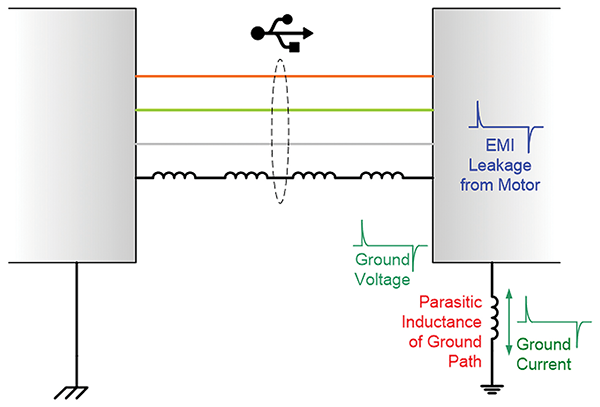
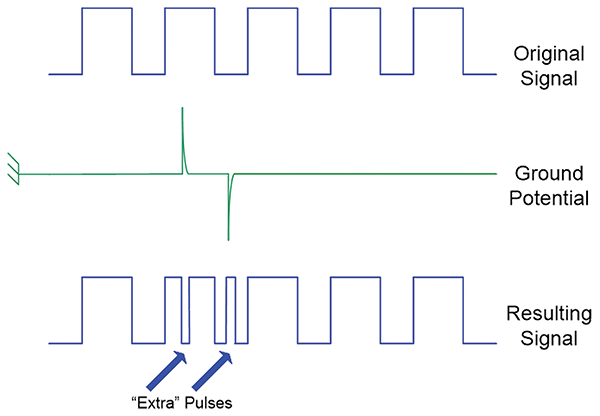
Figure 9 shows how current spikes from sources such as motor operation travel to the facility ground and thus create a voltage drop on the tool’s ground wiring. The resulting voltage on the tool’s ground is no longer the same as the facility ground, and not the same as the ground of another tool with which the tool is trying to communicate (in this example, the USB). In such conditions, logic levels are no longer valid as shown in Figure 10, and the very next logic gate can easily mistake 1 for 0 and vice versa, depending on the timing and the amplitude of such interference. The worst part of it is that there is no record in the system of such occurrence, and reproducing it is often impossible.
I Have EMI on Ground – Now What?
Simply understanding the problem is only the first step in resolving it. There are several methodologies to mitigate EMI issues on ground. All revolve around the same three basic principles:
- Reduce EMI at the source;
- Block propagation of EMI; and
- Reduce susceptibility of your circuit/devices to EMI
Depending on whether you are an equipment designer or an equipment user, your options may vary.
Reducing EMI at the Source
The two biggest sources of EMI in equipment are pulse width modulation (PWM) motors (e.g., servo, stepper, and VFD), and switched-mode power supplies (SMPS). If we manage to decrease dV/dt of the edges of their pulses (in other words, slow down the signal transitions), there will be less EMI to induce on ground. Designers of PWM drives and SMPS are trying to make these edges as sharp as possible so that the output transistor drivers do not heat up as much and the circuit is simpler. Typical rise/fall times of drive pulses in a servo motor are around 50nS, which translates into the spectrum of up to 20MHz.
It is now our job to make these drives and SMPS work for us in the way we want them to. The only practical way to increase the rise and fall times of pulse edges is filtering. For SMPS, the more filtering that is applied to their DC output the better. PWM drives require a more careful approach since trying to filter pulsed drive signals may easily make the motors perform poorly or not work at all.
Figure 11 shows the original rise edge of a servo motor drive pulse, and the modified edge after applying a servo motor filter. Figures 12a and 12b show the result of such edge modification, with a ground current drop of around 50 times.
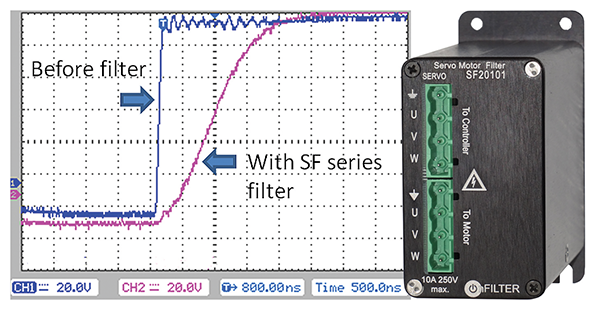
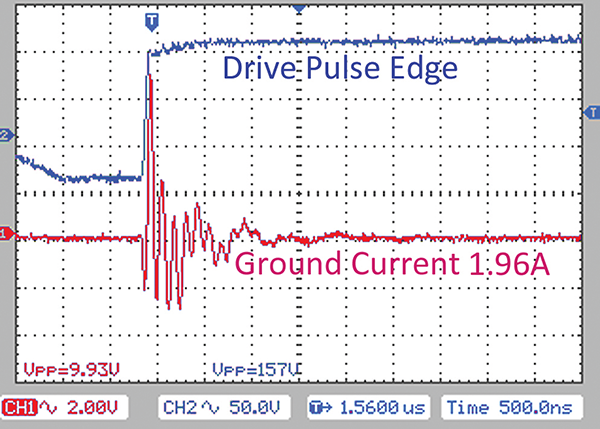
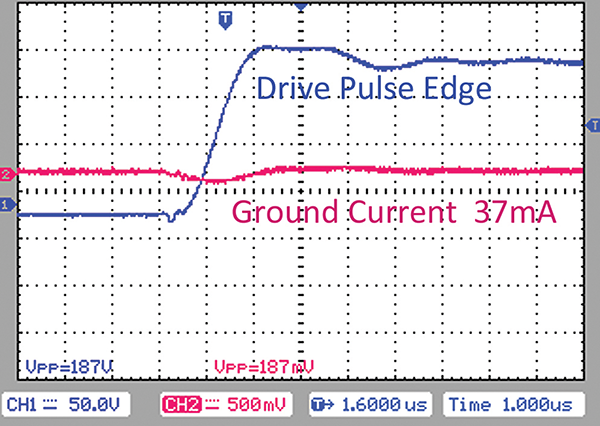
For reducing EMI from switched-mode power supplies, DC filters such as the one shown in Figure 13 are often used, since they remove high-frequency content from DC supply.
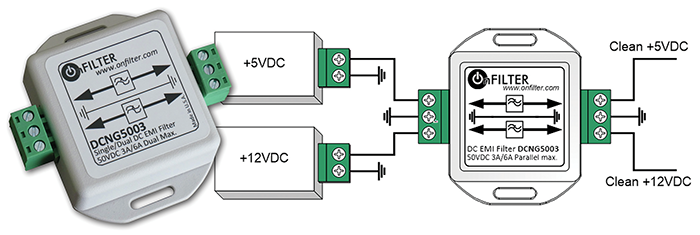
Blocking Propagation of EMI
Filtering of EMI is just like filtering polluted water, in which you block contaminants and let clean water pass through. Our readers are likely already familiar with the concept of filtering EMI on wires and cables, even if they never considered a filter. The ubiquitous ferrite clamp (typically a black lump on a computer cable) is, in fact, an EMI filter for cables. From a technical perspective, a ferrite clamp is a current transformer with a shorted secondary that converts high-frequency signals in cables into heat (no, you won’t be able to check it by touch – the energy is too low to be noticed this way). And ferrite clamps are inexpensive and easy to implement.
The problem is their limited performance. Most ferrite clamps become effective only at the higher end of the spectrum, above 50MHz or so (a lot of energy of EMI in manufacturing is below 1 MHz), and the attenuation they offer at these frequencies is largely limited to 10dB. A ferrite clamp is often the first way to bring EMI propagation in check. But using a ferrite clamp is not unlike using a band-aid. It will stop minor bleeding and cover a small scratch, but it just won’t be sufficient in cases involving more serious injuries.
Ground EMI filters, such as the one shown in Figure 14, offer much better performance by providing substantial attenuation of broadband signals while also providing low impedance for the mains’ frequencies (let’s not forget that ground is a safety element). One of the applications of a ground filter is shown in Figure 15. It addresses the issue of EMI-caused EOS exposure, as shown in Figure 8. The modification is straightforward and involves an insulative plate made of mechanically hard material, such as FR4, Bakelite, or equivalent, sandwiched between the parts of the robotic arm and the end piece is grounded via the filter of Figure 14. (See [24] for a detailed description of the implementation of such filtering in an IC handler in production).
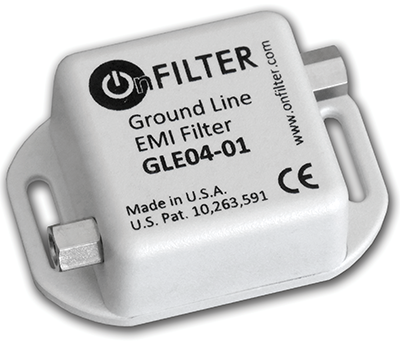
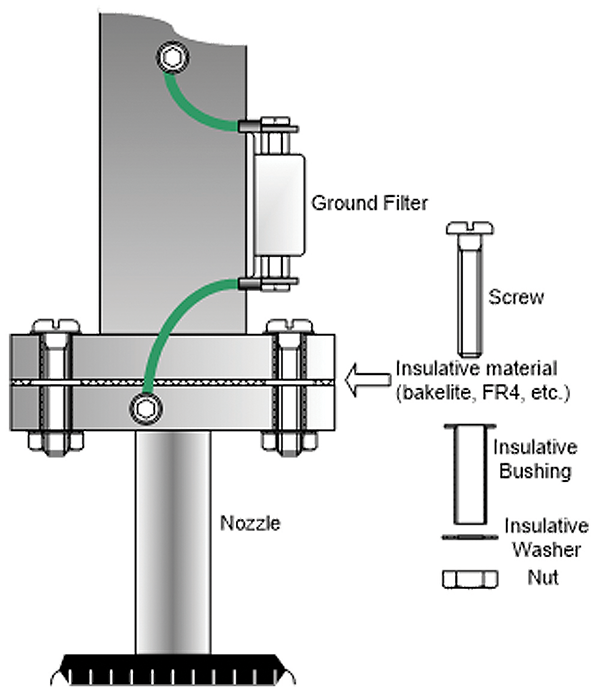
Figures 16a and 16b show ground current between the robotic arm and the corresponding chassis without and with the filter. Such a ground filter inserted in wires for ESD grounding inside equipment will block the propagation of EMI throughout the tool while complying with all relevant ESD and safety standards. A similar approach with similar results can also be taken at a facility ground level, especially in facilities that employ separate grounding. In such cases, inserting a ground filter every few meters prevents EMI from propagating from noisy tools to the tools that require a low-noise environment.
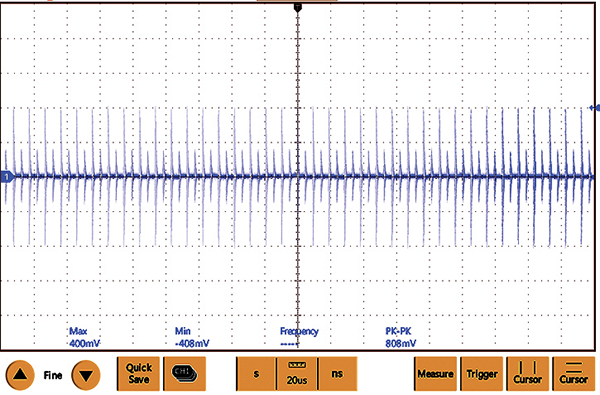
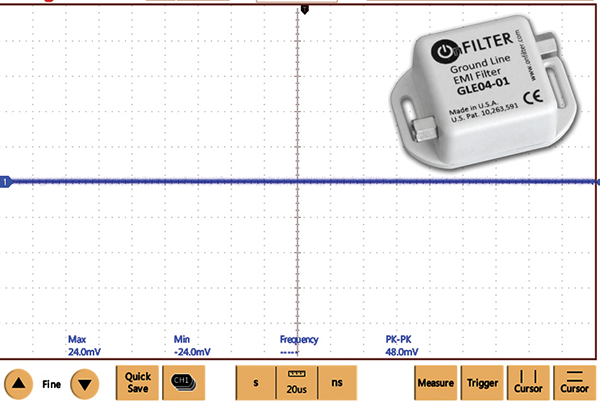
The key takeaway about ground filters is remembering that grounding is a safety element and that use of ground filters should not influence compliance with relevant ESD standards and practices.
Conclusion
Proper grounding extends beyond just running a green wire. A good grounding can help ensure the uninterrupted operation of your equipment and the integrity of your data, while a bad ground can do just the opposite. Whether you are an electrician, an ESD practitioner, or an EMC engineer, you should consider and address not just the aspect of grounding that aligns with your specialty but all grounding considerations, including safety, ESD, EMI, and data integrity. In most cases, a single standard cannot sufficiently account for all needs in the process. Pay special attention to EMI on ground as it connects all equipment and is a conduit for EMI spread. Comprehensive, quality ground is a solid foundation to help ensure the smooth and efficient running of your processes and equipment.
Endnotes
- Due to its construction, some equipment may have electrically floating metal parts, i.e., not electrically connected to anything. These parts are generally small. Special care must be exercised to assure that such floating pieces of metal physically cannot have electrical contact with live voltage.
References
- ANSI/ESD 6.1-2019 Standard Practice for the Protection of Electrostatic Discharge Susceptible Items – Grounding, EOS/ESD Association.
- ANSI/ESD S20.20-2014 Development of an Electrostatic Discharge Control Program for Protection of Electrical and Electronic Parts, Assemblies and Equipment (Excluding Electrically Initiated Explosive Devices), EOS/ESD Association.
- SEMI E.176 Guide to Assess and Minimize Electromagnetic Interference (EMI) in a Semiconductor Manufacturing Environment, SEMI.
- ESD SP10.1-2016 Standard Practice for the Protection of Electrostatic Discharge Susceptible Items – Automated Handling Equipment (AHE), EOS/ESD Association.
- IEC 61340 Protection of Electronic Devices from Electrostatic Phenomena – General Requirements, IEC, 2016.
- “Improved IC Production Yield by Taking Into Account the Electromagnetic Interference Level During Testing,” Cheng-Nan Hu et. al., IEEE Transactions on Electromagnetic Compatibility, 7/2011.
- ANSI/ESD S1.1-2013 Standard for the Protection of Electrostatic Discharge Susceptible Items – Wrist Straps, EOS/ESD Association.
- “Don’t Be the Victim of Electrical Noise and EMI,” J. Moulton, Control Engineering, October 2015.
- “Mitigating EMI Issues in Servo Motors and Variable Frequency,” V. Kraz, Interference Technology, Test and Design Guide, 2016.
- https://www.allaboutcircuits.com/tools/wire-self-inductance-calculator
- https://www.daycounter.com/Calculators/Air-Core-Inductor-Calculator.phtml
- https://www.emisoftware.com/calculator/wire-pair-capacitance
- “Measurements of Conducted Emission in the Manufacturing Environment,” V. Kraz, In Compliance Magazine, Annual Guide 2021
- “Reducing EOS Current in Hot Bar Process in Manufacturing of Fiber Optics Components,” J. Salisbury et.al., EOS/ESD Symposium Proceedings, 2016.
- “EMI-Generated EOS in a Wire Bonder,” T. Iben, EOS/ESD Symposium Proceedings, 2017.
- “Dealing With EMI in Semiconductor Manufacturing, Part II: SEMI E176-1017 Standard,” V. Kraz, In Compliance Magazine, May 2018
- “The Implementation of SEMI E176: Guide to Assessing and Minimizing Electromagnetic Interference in a Semiconductor Manufacturing Environment,” V. Kraz et. al., In Compliance Magazine, September 2019
- “How Ground Bounce Can Ruin Your Day,” S. Krishnan et. al., Signal Integrity Journal, February 2020.
- “Managing Electromagnetic Interference in Large Instrumentation Systems,” M. Gruchalla et.al., Proceedings of IBIC2014, Monterey, CA, USA.“
- About Ground Bounce and How to Measure It,” Teledyne LeCroy, 2018.
- EMI dV/dt Filters for Servo Motors and VFD, OnFILTER, 2017.
- Dual DC EMI Filter 3/6A 50V, OnFILTER, 2021.
- Ground Line EMI Filter for Grounding Inside Equipment, OnFILTER, 2014.
- “Practical Aspects of Managing EMI-Caused EOS in IC Handlers and Similar Equipment,” J.J. Montalban, et. al., EOS/ESD Symposium Proceedings, 2021.
